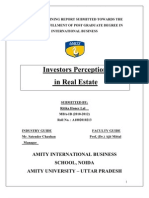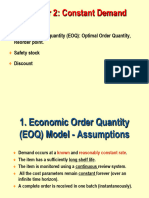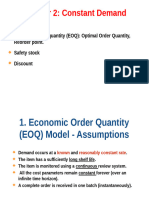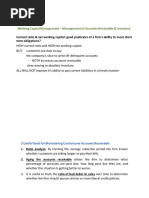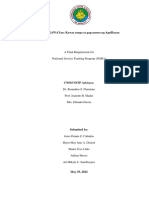Module 3 - Supply Chain Management Practice Problems
Uploaded by
watosoxModule 3 - Supply Chain Management Practice Problems
Uploaded by
watosoxModule 3 – Supply Chain Management
Practice Problems
1. Consider an item that is ordered on a monthly basis. The daily demand for the item is
200 and the lead-time for supply is 7 working days. A month consists of 25 working
days.
a. What is the average cyclic inventory in the system?
b. What is the pipeline inventory in the system?
2. For the above problem let the cost of ordering is USD 100 per order and the cost of
carrying inventory is USD 10 per unit per year of inventory.
a. What will be the cost of the existing plan of ordering inventory?
b. What will be the economic order quantity (EOQ)?
c. What will be the new cost of the plan if the organization chose to order as per
EOQ?
3. ABC, an electrical component manufacturer requires certain copper items in large
quantities. The annual requirements are 40,000 pieces each costing INR* 450. The
ordering cost is INR. 600 per order and the carrying cost is INR 100 per unit per year.
a. What is the optimal order quantity?
b. How frequently should XYZ place the order with the supplier?
c. Compute the total ordering cost and total carrying cost?
d. Do you notice anything by examining both the elements of the cost?
* (INR means Indian Rupee)
4. Consider the above situation. Suppose the demand has gone up by 10%. What will be
the impact (in terms of the cost of the plan) if the company decides to order with the
revised EOQ?
5. Consider an item with the following demand attributes:
Mean weekly demand = 140; Standard deviation of weekly demand = 50; Review
Period = 2 weeks.
a. Compute the safety stock required for a periodic review system when the lead
time is 1 week and the desired service level is 95%.
b. What is the order-up to-level for this policy?
6. Oriental Healthcare is a multi-specialty hospital catering to a variety of illnesses
connected to the heart and respiratory systems. The demand for a class of medical
consumable is generally random. Recently, an examination of the stores records over
a period of 10 weeks revealed the following weekly consumption pattern:
Week No. Consumption
(Units)
1 120
2 109
3 89
4 140
5 110
6 145
7 77
8 120
9 130
10 80
The supplier of the item takes on an average 2 weeks to deliver once the order is
placed. Design an appropriate inventory control policy for a periodic review system
for a review frequency of 4 weeks for a 99% service level
Answers to the problems
1 (a) Every time the inventory ordered is 5,000. Since the inventory in the system
varies from 5,000 to 0, the average cyclic inventory is 2500; 1 (b) 1400
2 (a) USD 26,200; (b) 1095.45 (or 1096); (c) USD 10,960
3 (a) 692.8 (or 693); (b) 57.74 (or 58) orders in a year; (c) total ordering cost = total
carrying cost = 34,640 (numbers may slightly vary if we compute with rounded
values) (d) Both values are same (numbers may slightly vary if we compute with
rounded values)
4 For the increase in demand (10%). if we revise EOQ and accordingly the cost of the
plan, the new cost is total ordering cost = total carrying cost = 36,332, representing
only about 4.88% increase in cost of the plan.
5 (a) 142.46; (b) 562.46
6 Mean of weekly demand = 112; Std. Deviation of weekly Demand = 23.84
For 99% service level Z value is 2.326;
Safety stock = 135.83; Order-up to–Level = 807.83
You might also like
- Operations Management: Section D and E BATCH 2019 60 Marks Duration: Three HoursNo ratings yetOperations Management: Section D and E BATCH 2019 60 Marks Duration: Three Hours6 pages
- Implementing An Improved Inventory Control System in ANo ratings yetImplementing An Improved Inventory Control System in A24 pages
- Module 3 Practice Problems - Classnotesforfools PDFNo ratings yetModule 3 Practice Problems - Classnotesforfools PDF2 pages
- Module5 Unit2 InventoryManagement Systems-ToolsNo ratings yetModule5 Unit2 InventoryManagement Systems-Tools20 pages
- Production Planning and Control (MEFB 433) : Ts. Zubaidi Faiesal Email: Zubaidi@uniten - Edu.my Room No.: BN-1-010No ratings yetProduction Planning and Control (MEFB 433) : Ts. Zubaidi Faiesal Email: Zubaidi@uniten - Edu.my Room No.: BN-1-01026 pages
- Chapter 2st - Single Item - Demand Varying at Approximate LevelNo ratings yetChapter 2st - Single Item - Demand Varying at Approximate Level35 pages
- Chapter 2 - Single Item - Demand Varying at Approximate LevelNo ratings yetChapter 2 - Single Item - Demand Varying at Approximate Level49 pages
- MSE407 Manufacturing Systems: Single-Stage Inventory ControlNo ratings yetMSE407 Manufacturing Systems: Single-Stage Inventory Control44 pages
- Operations Management Session 08 and 09 Chap 6 QuxHPR4gegNo ratings yetOperations Management Session 08 and 09 Chap 6 QuxHPR4geg42 pages
- 3.0 Accounting For Materials, Labor, and OH 2023No ratings yet3.0 Accounting For Materials, Labor, and OH 202310 pages
- Problem: Inventory Management (Chapter 12) Problem-01No ratings yetProblem: Inventory Management (Chapter 12) Problem-0123 pages
- Chapter 2st - Single Item - Constant DemandNo ratings yetChapter 2st - Single Item - Constant Demand33 pages
- Ch-05 Material Inventory Controls (Online Class)No ratings yetCh-05 Material Inventory Controls (Online Class)6 pages
- Answer FOUR Questions Only. ALL Questions Carry EQUAL MarksNo ratings yetAnswer FOUR Questions Only. ALL Questions Carry EQUAL Marks8 pages
- Chapter 2st - Single Item - Demand Varying at Approximate LevelNo ratings yetChapter 2st - Single Item - Demand Varying at Approximate Level35 pages
- Chapter 4 - Inventory Control Management - AddedNo ratings yetChapter 4 - Inventory Control Management - Added41 pages
- Working Capital Management - Management of Accounts Receivable & InventoryNo ratings yetWorking Capital Management - Management of Accounts Receivable & Inventory13 pages
- Purchasing, Inventory, and Cash Disbursements: Common Frauds and Internal ControlsFrom EverandPurchasing, Inventory, and Cash Disbursements: Common Frauds and Internal Controls4.5/5 (3)
- Demand-Driven Inventory Optimization and Replenishment: Creating a More Efficient Supply ChainFrom EverandDemand-Driven Inventory Optimization and Replenishment: Creating a More Efficient Supply ChainNo ratings yet
- Terms & Conditions Cash Rebate Platinum Credit Card: 1 July 2018No ratings yetTerms & Conditions Cash Rebate Platinum Credit Card: 1 July 201811 pages
- Ing: An Agile Organization in A Disruptive EnvironmentNo ratings yetIng: An Agile Organization in A Disruptive Environment19 pages
- Income Tax Exemption Under Section 80IAC of IT Act 1961No ratings yetIncome Tax Exemption Under Section 80IAC of IT Act 19613 pages
- Amazon Case Study Model Data File - FinalNo ratings yetAmazon Case Study Model Data File - Final42 pages
- Clean Edge Razor: Splitting Hairs in Product PositioningNo ratings yetClean Edge Razor: Splitting Hairs in Product Positioning23 pages
- Referencer For Quick Revision: Final Course Paper-1: Financial ReportingNo ratings yetReferencer For Quick Revision: Final Course Paper-1: Financial Reporting44 pages
- G9 Business Studies - Assessment Week Nov 2023-24No ratings yetG9 Business Studies - Assessment Week Nov 2023-247 pages
- Part One:: Innovative Ideas, Without Cutting Into The (1) - Bottom Line - ?No ratings yetPart One:: Innovative Ideas, Without Cutting Into The (1) - Bottom Line - ?6 pages





